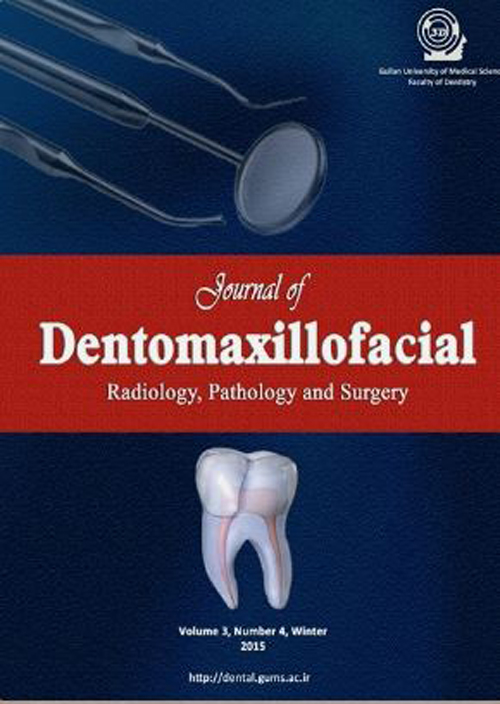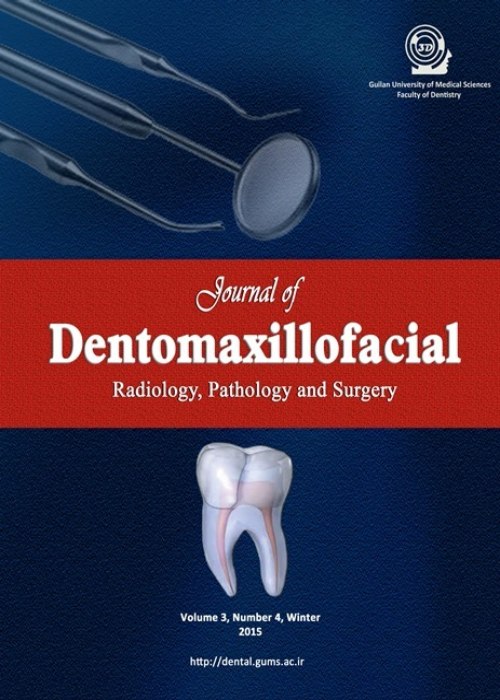فهرست مطالب

Journal of Dentomaxillofacil Radiology, Pathology and Surgery
Volume:10 Issue: 4, Autumn 2021
- تاریخ انتشار: 1400/11/17
- تعداد عناوین: 6
-
-
COVID-19 and Orthodontic Emergencies: A Narrative ReviewPages 1-5
COVID-19 pandemic has faced orthodontists with challenges. The number of unnecessary orthodontics visits should be decreased to stop the spread of this virus. However, if the patients undergoing orthodontic treatments are not followed for more than two months emergencies can occur. Hopefully these emergencies can mostly be handled at home if the orthodontist guides the patient correctly. This study attempted to gather the available solutions for the management of these emergencies, so that orthodontists can help their patients and to decrease the unnecessary
appointments during the COVID-19 pandemic.Keywords: Pandemics Emergencies Orthodontics COVID-19 Dental Care -
Pages 6-11Introduction
Mechanical plaque removal is the most reliable method of oral hygiene practice. However, to maximize its effect, it should be accompanied by the use of chemical agents such as toothpastes, mouth washes and fluoride gels. This study aimed to compare the effect of tooth brushing with an Iranian toothpaste compared to a commonly used foreign-made toothpaste on plaque index (PI) of 9- to 12-year- old children.
Materials and MethodsThis randomized single-blind crossover clinical trial was conducted on 26 children between 9 to 12 years old. Participants were randomly divided into two groups. The difference between the two study groups was the order of Bas and Crest toothpaste application. Dental prophylaxis were done for all teeth to reduce PI score to zero. The children were then requested to brush their teeth with the first toothpaste and use dental floss before going to bed for one week. At the end of the first week, Turesky’s PI was measured. After a one-week washout period, the PI was reached to zero again and the toothpaste was changed and participants used the second toothpaste for one week. PI was measured again and the values were compared using paired t-test (alpha=0.05).
ResultsThe mean PI in “Bas” toothpaste group (1.486±0.398) was significantly higher than that in “Crest” toothpaste group (1.256±0.229) (P=0.014).
ConclusionThe results showed that “Crest” toothpaste was significantly more effective for plaque control than “Bas” toothpaste in our study population.
Keywords: Child Toothpastes Dental Plaque Index Family -
Pages 12-16Introduction
Orthodontic treatment can cause difficulties in maintaining good oral hygiene leading to the accumulation of dental plaque, gingival inflammation, periodontal disease, and caries. This study aimed to evaluate the efficacy of three different tooth brushing techniques on the prevention of periodontal diseases in patients with fixed orthodontics treatment.
Materials and MethodsIn this parallel-group, double-blind randomized controlled trial, 57 patients undergoing fixed orthodontic treatment with mild gingivitis were randomly divided into three groups (scrub, modified Stillman, and modified bass) using a simple randomization technique. The patients were instructed to brush their teeth three times a day and to floss once a day. Gingival (Silness and Loe) and plaque indices (O’Leary and Quickly hein) were recorded at baseline, after 2 weeks and after 3 months. ANOVA and Post Hoc tests were used; otherwise, Kruskal-Wallis test and Post Hoc tests were used in SPSS 24. The significance level was set at p>0.05.
ResultsGingival index and plaque indices (Quickly hein and O-Leary) significantly decreased when using 3 methods of tooth brushing (respectively p>0.001, p˂0.05 and p>0.001). However, age and gender had no statistically significant relationship with recorded periodontal parameters in the three groups of subjects.
ConclusionAll three studied methods were effective in the reduction of gingival and plaque indices in patients undergoing orthodontic treatment.
Keywords: Oral Hygiene, Toothbrushing, Orthodontics, Dental Plaque, Periodontal Index -
Pages 17-22Introduction
Considering the importance of anterior teeth in chewing, speaking and esthetics, as well as the high prevalence of crown fracture among various traumatic injuries to the teeth, this study aimed to evaluate the etiology and risk factors associated with crown fractures of anterior teeth in 7-12 years old children.
Materials and MethodsThis descriptive cross-sectional study was performed on a total of 742 children. Gender, current age, the age at which the dental trauma occurred, the type of the dental trauma, the etiology, the location, overjet, overbite and lip coverage were recorded for each child. The Chi-Square and Mann-Whitney tests were used to analyze the data with SPSS 16 software. The level of significance was set at 0.05.
ResultsAmong 742 children, 84 children (11.3%) had crown fractures of permanent anterior teeth. Of the 84 children, 54 were boys (64.3%) and 30 were girls (35.7%), showing a ratio of boys to girls 1.8 to 1. The most common type of crown injury was enamel fracture (67.8%). Most injuries occurred at home (46.4%) and in summer (41.7%). The most common cause of anterior teeth crown fracture was falling (45.2%). Increased overjet and overbite and lip incompetency were found as predisposing factors for anterior teeth crown fracture.
ConclusionConsidering the importance of the anterior teeth, preventive educational programs should be instituted directing parents and school teachers to inform them about the dental trauma and its complications.
Keywords: Dentition, Permanent Prevalence -
Pages 23-27
Human maxillary first molars are usually considered as three-rooted teeth with four root canals for the presence of a second canal in the Mesio Buccal root (MB2). In addition, lateral ramifications and apical delta of the root canal system may frequently occur, increasing the probability of leaving untreated spaces after the root canal therapy. A thorough knowledge of root canal morphology and good anticipation of their possible morphological variations may help to prevent iatrogenic errors and ensure success. The importance of the knowledge of the anatomy of root canals cannot be overemphasized. Unusual root and root canal morphologies associated with maxillary molars have been reported in several studies, in the literature. This clinical report presents a permanent maxillary first molar with an unusual morphology of two roots with two canals.
Keywords: Dental Pulp Cavity -
Pages 28-34Introduction
This study sought to assess the performance of 4th year dental students in detection of residual roots on panoramic radiographs of edentulous patients.
Materials and MethodsThis cross-sectional study evaluated 37 fourth-year dental students of School of Dentistry, Qazvin University of Medical Sciences. Ten panoramic radiographs of edentulous patients with residual roots in their alveolar ridge were retrieved from the archives of the Radiology Department and a private clinic. The residual roots were identified by two radiologists, and their diagnoses served as the gold standard. Dental students were then requested to detect and mark the residual roots on panoramic radiographs using Scanora software. The performance score of each student was calculated by the ratio of correct diagnoses to the total number of diagnoses. The mean performance score was analyzed based on gender and grade point average (GPA) of students. Data were analyzed using STATA version 14.0 at 0.05 level of significance.
ResultsThe mean performance score of students was found to be 62.9% (6.9). Male and female students had no significant difference in performance score (P>0.05). Educational status (GPA) and performance score were not correlated (P>0.05). Enostosis and sclerotic socket were the most common differential diagnoses mistaken for residual root by the students.
ConclusionThe performance score of 4th year dental students of Qazvin University in detection of residual roots on panoramic radiographs was moderate. The educational curricula should be revised, and further emphasis should be placed on this topic in practical courses.
Keywords: Radiography, Panoramic Diagnosis, Differential Work Performance Education, Dental


